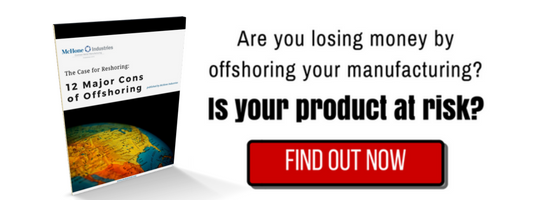
The year 2020 has changed the playing field for the manufacturing game.
Bringing American manufacturing jobs back home is looking better and better.
The COVID-19 pandemic showed manufacturers how a world event can easily -- and drastically -- impact the global supply chain. But it’s the latest reason many American manufacturers are considering reshoring their operations.
During the last several years:
- The United States pulled out of the Trans-Pacific Partnership
- NAFTA remains under scrutiny
- American demand for American-made products is on the rise
For OEMs looking to control costs and maintain production schedules, American metal fabricators are an even more attractive option. Click below to weigh the pros and cons of reshoring your metal manufacturing:
Choosing an American Metal Fabricator for Reshoring
Whether your company is looking to reshore based on rising wages overseas, lack of supply chain control, IP protection, or moral reasons, you should know what boxes to check when reshoring. The most important ones to consider are:
- Total cost of ownership (TCO)
- Shipping/Transportation
- Taxes
- One-stop shop
- Government Incentives
- Energy costs and real estate
- IP and Engineering
Here’s how each impacts your move to reshore:
1. TCO
The main reasons companies reshore is the total cost of ownership (TCO). Offshore manufacturing looks great on paper, if you only consider unit costs. When you factor in all costs associated with foreign manufacturing, project costs skyrocket.
Similarly, when evaluating American manufacturers, consider supply chain costs from beginning to end. This TCO calculator from the Reshoring Initiative makes it easy.
2. SHIPPING/TRANSPORTATION
The closer your manufacturer is, the easier your life is.
Keeping production close means:
- More facility visits to check on operations
- Shipping costs stay low
- Lead times are minimized
- Reaction to customer demands is swifter
3. TAXES
Along with shipping costs, taxes vary greatly by state and locality. Taxes affect inventory management, material costs, equipment purchases, and the structure of your American-based supply chain.
4. CAN IT PROVIDE ALL-IN-ONE SERVICES?
Some companies prefer to divide their supply chain among multiple vendors. Others prefer the convenience of contracting with a full-service metal fabricator.
If you require services throughout the supply chain, consider choosing a supplier who can fill all those needs in one location. This makes paperwork easy, gives you more control, streamlines communication, and makes it easier to identify what went wrong if a problem crops up.
5. GOVERNMENT INCENTIVES
Part of our reshoring efforts involve overhauling the “benefit” side of the cost-benefit scale.
To promote American manufacturing, governments at all levels are partnering with manufacturers to offer grants as well as other financial and operating incentives. These incentives vary by state and local government.
6. ENERGY COSTS & REAL ESTATE
Two areas where American manufacturing easily K.O.s offshoring. Many foreign countries are struggling to find land to build factories, and energy costs are through the roof. These can drastically inflate the cost of offshore manufacturing.
While you'll save a lot of money in this category by moving to America, you can further refine your energy and real estate costs depending on the location of your metal fabrication shop. Consider:
- Access to resources
- Power pricing (varies between $.04 - $.12 / kilowatt hour)
- Waste disposal -- where, how, and how much energy will it take?
These factors can vary even between manufacturers in the same city.
7. IP & ENGINEERING
One of the benefits of American manufacturing is highly educated, creative talent. Some manufacturers can assist in value engineering your product -- making it as affordable and quick to produce as possible.
Are You at Risk Without an American Metal Fabricator?
Reshoring is a big commitment and a big investment. Consider these things, and fully evaluate an American metal fabricator before signing a contract.
(Editor’s note: This blog was originally posted in February 2017 and was recently updated.)



